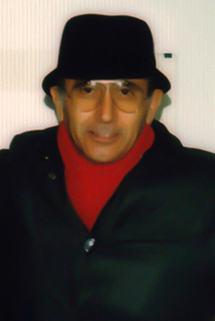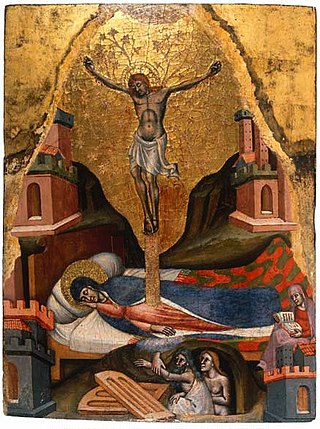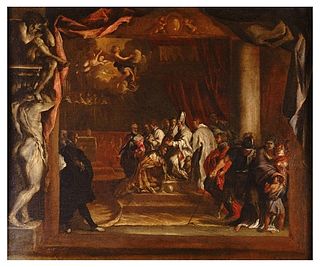
Jacopo di Paolo (1345 approx. - 1430 approx.) was an Italian painter and miniaturist active in Bologna in the fourteenth and fifteenth centuries.

Jacopo di Paolo (1345 approx. - 1430 approx.) was an Italian painter and miniaturist active in Bologna in the fourteenth and fifteenth centuries.

Jacopo di Paolo at the beginning of his career was active at Mezzaratta Church, where he frescoed two Stories of Moses. These pieces were probably based on ideas of Jacopo Avanzi and have a clear influence of the new-giottism and late Gothic of Giovanni da Modena. The strong sense of plasticity in the figures and the rationality of the space system, evident in some works exposed such as the St. John the Baptist, are the result of a different and new reflexion on Giotto's experience. Even though there is a generational gap between Simone and Jacopo and they both were capable of obtaining important recognition in Bologna, it was Jacopo that also received prestige within the public arena. [1]
The activity of Jacopo was very versatile, as he was engaged at various levels within the fervent political and cultural life of the city. He worked in several prestigious decorative undertakings of the city, sometimes in collaboration with sculptors, such as in the “yard” of San Petronio, launched in 1390. For this he provided the drawings for the sculptures of the base of the façade, the project for the windows, and the wooden altarpiece in the chapel of the Magi by Bartolomeo Bolognini. [2]


Giacomo Antonio Perti was an Italian composer of the Baroque era. He was mainly active at Bologna, where he was Maestro di Cappella for sixty years. He was the teacher of Giuseppe Torelli and Giovanni Battista Martini.

Giovanni Bononcini was an Italian Baroque composer, cellist, singer and teacher, one of a family of string players and composers. He was a rival to George Frederic Handel.

GiacomoBarozzida Vignola, often simply called Vignola, was one of the great Italian architects of 16th century Mannerism. His two great masterpieces are the Villa Farnese at Caprarola and the Jesuits' Church of the Gesù in Rome. The three architects who spread the Italian Renaissance style throughout Western Europe are Vignola, Serlio and Palladio. He is often considered the most important architect in Rome in the Mannerist era.

Giacomo Cavedone was an Italian Baroque painter of the Bolognese School.

Franco Fontana is an Italian photographer. He is best known for his abstract colour landscapes.

The Basilica of San Petronio is a minor basilica and church of the Archdiocese of Bologna located in Bologna, Emilia Romagna, northern Italy. It dominates Piazza Maggiore. The basilica is dedicated to the patron saint of the city, Saint Petronius, who was the bishop of Bologna in the fifth century. Construction began in 1390 and its main facade has remained unfinished since. The building was transferred from the city to the diocese in 1929; the basilica was finally consecrated in 1954. It has been the seat of the relics of Bologna's patron saint only since 2000; until then they were preserved in the Santo Stefano church of Bologna.

Vitale da Bologna, also known as Vitale di Aymo de' Cavalli or Vitale degli Equi, was an Italian painter of the Early Renaissance.

Antonio Randa was an Italian painter of the classicist period, active in Ferrara, Modena, Rovigo, Florence, Comacchio and his native Bologna.
Alberto Melloni is an Italian church historian and a Unesco Chairholder of the Chair on Religious Pluralism & Peace, primarily known for his work on the Councils and the Second Vatican Council. Since 2020, he is one of the European Commission's Chief Scientific Advisors.

Pelagio Palagi was an Italian painter, sculptor and interior decorator.

Antonio del Massaro da Viterbo, or Antonio da Viterbo, nicknamed il Pastura was an Italian painter.

Simone di Filippo Benvenuti, known as Simone dei Crocifissi or Simone da Bologna, was an Italian painter. Born and died in Bologna, he painted many religious panel paintings, and also frescoes in the churches of Santo Stefano and San Michele in Bosco, both at Bologna.

Igino Benvenuto Supino was an Italian painter, art critic, and historian.

Carlo Caproli or Caprioli, also called Carlo del Violino, was an Italian violinist, organist, and a leading composer of cantatas in mid-17th-century Italy.

The Museo Civico di Sansepolcro or Museo Comunale is the town or comune art gallery. It is housed in a series of linked palaces, including the medieval former Palazzo della Residenza, the Palazzo dei Conservatori del Popolo and the Palazzo del Capitano o Pretorio, located on Via Niccolò Aggiunti #65, near the center of Sansepolcro, formerly Borgo Santo Sepolcro, in the Province of Arezzo, region of Tuscany, Italy. The museum was founded in 1975.

Antonio Aldini was an Italian lawyer and politician, active in the Cisalpine Republic, the Italian Republic and the Kingdom of Italy.

Charles V was crowned Holy Roman Emperor by Pope Clement VII in the San Petronio Basilica in Bologna on 24 February 1530. He was the last Holy Roman Emperor to be crowned by a pope. The emperor was also crowned King of Italy on 22 February, also the last coronation of an Italian king by a pope.

Tiburzio Passarotti or Passerotti was an Italian painter, primarily of religious subjects.
Elia Vannini era un frate carmelitano, compositore di musica barocca. Fu maestro di cappella nella cattedrale di Ravenna dal 1677 al 1701. Pubblicò 5 opere. Nel XVIII secolo la sua musica continua a essere suonata per alcuni decenni dopo la sua morte. A partire dagli anni ‘70 del XX secolo un rinnovato interesse verso la sua musica portò a nuovi studi delle sue opere e a concerti pubblici. Una scuola primaria di Medicina è stata dedicata proprio ad Elia Vannini.